Brick Driveway: Is It The Right Choice for You?
When it comes to revamping your property, the choice of driveway material can significantly impact the aesthetic appeal, functionality, and sustainability.
This article explores the intricacies of brick driveways, their installation, maintenance, and design options, as well as cost considerations. We will also delve into the innovative solution of TRUEGRID® driveways, a durable and eco-friendly alternative, by offering insights through real-life examples.
Why Brick Driveways Are In Demand
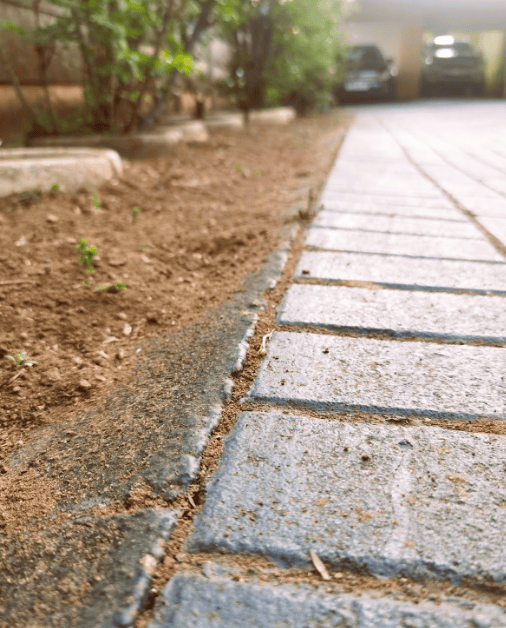
Brick driveways are increasingly popular due to their unique combination of aesthetic appeal and practical benefits. Their distinctive look offers a range of colors and patterns and adds a classic and elegant touch to any property. Additionally, brick driveways are appreciated for their durability and eco-friendly qualities, as they often use natural materials and can have a long lifespan, with proper maintenance.
This blend of visual charm and functional advantages makes them a sought-after choice for homeowners looking to enhance their property’s curb appeal and value
The Pros and Cons of Opting for a Brick Driveway
Pros of a Brick Driveway
Aesthetic Appeal
Brick driveways offer a distinct and attractive look that surpasses the visual appeal of traditional concrete or asphalt driveways. The flexibility in design allows for creative patterns that can add a touch of artistry to your property.
Durability and Smooth Finish
Contrary to some beliefs, brick driveways can provide a smooth surface that can accommodate heavy traffic without significant wear and tear. They are built to last and to support substantial vehicle weight.
Eco-Friendliness
Often made from natural materials, brick driveways are considered more environmentally-friendly. Their longevity of around 25 years reduces the need for frequent replacements.
Cons of a Brick Driveway
Maintenance Requirements
Regular cleaning and resealing are crucial to maintain the integrity of a brick driveway. Without proper upkeep, the porous nature of bricks can lead to quicker erosion and damage.
Cost
Initially, brick driveways may cost more compared to other materials like concrete. The need for regular maintenance can also add to the long-term expenses.
Limited Design Options
Although available in a range of earth tones, brick driveways are somewhat limited in terms of shape and size variations, especially when compared to concrete pavers.
Building Your Brick Driveway: From Installation to Design
Installation Process
Installing a brick driveway is a detailed process that requires careful planning and precision to ensure longevity and functionality. Here’s a general overview of the installation steps:
- Site Preparation: The first step involves preparing the site. This includes clearing any vegetation, debris, or old paving materials. The ground is then leveled and graded to ensure proper drainage.
- Foundation Creation: A strong foundation is the key to the durability of a brick driveway. It typically involves excavating to a certain depth (often around 12 inches), followed by laying a layer of compacted gravel. The depth of excavation and the type of gravel used can vary depending on the soil type and climate.
- Sand Layering: After the gravel, a layer of sand is spread out to create a smooth, even surface. The sand acts as a cushion for the bricks and helps to lock them in place once they are installed.
- Laying Bricks: The bricks are laid on the sand bed in the chosen pattern. The bricks should be tightly placed together. Cutting may be required to fit bricks at the edges or around obstacles.
- Edging and Securing: To keep the bricks from shifting, edging materials such as metal or plastic edging are often installed around the perimeter of the driveway.
- Sand Filling and Compaction: After all the bricks are laid, additional sand is swept into the joints between the bricks. The driveway is then compacted using a plate compactor to settle the bricks and lock them in place.
- Finishing Touches: The final step involves cleaning the surface and checking for any uneven or loose bricks that need adjustment.
Installation Process Compared
- Concrete driveways require careful handling during pouring and curing, but they are less intricate to install.
- Asphalt driveways are quicker to install as the material is spread, leveled, and compacted with machinery.
- Brick and permeable pavers both require a detailed installation process, but permeable pavers are eco-friendly due to their water permeability.
Maintenance Costs
Repair Costs
Brick driveways have the advantage of individual brick replacement. If a brick gets damaged, it can be replaced without needing to redo the entire driveway. The cost for brick pavers ranges from $0.50 to $1.80 per brick, or $2 to $8 per square foot. Repairing spalling (where the surface layer flakes away) in brickwork can cost between $0.25 to $4 per brick.
Leveling Sunken Areas
If parts of the driveway become sunken, it can be rectified by removing the bricks, filling the space with sand, and re-compacting. This process helps to maintain a flat and even surface.
Tree Root Damage
In cases where tree roots spread underneath the bricks and cause an uneven surface, tree removal may be required. This can cost on average between $320 to $800.
General Maintenance
Regular cleaning and potentially resealing (depending on the brick type and exposure to substances like grease or oil) are important. Clay brick pavers typically do not need to be sealed unless frequently contacted by grease and oil, when they should be washed with water and detergent as needed.
Cost Variability
It’s important to note that these costs can vary significantly based on local labor rates, the extent of the damage, and the specific type of bricks used. Therefore, it’s always a good idea to get multiple estimates from local contractors for the most accurate cost assessment.
Maintenance Costs Compared
- Brick vs. Concrete: Brick driveways require individual brick replacement and periodic resealing, while concrete driveways may need less frequent but more extensive repairs like crack filling and surface resealing.
- Brick vs. Asphalt: Asphalt driveways require regular sealing and are more prone to cracking and fading which results in potentially higher long-term maintenance costs. On the other hand, brick driveways mainly require periodic cleaning and selective brick replacement.
- Brick vs. Permeable Pavers: TRUEGRID® permeable pavers are highly resistant to oils, gasoline, acids, salt, ammonia, and alcohol, unlike brick driveways. Their exceptional durability significantly reduces maintenance needs, which makes TRUEGRID® permeable pavers a cost-effective and low-maintenance choice compared to traditional brick driveways.
Brick Choice and Design
Variety in Paver Materials
Homeowners can choose from a range of materials for their driveway pavers, including concrete, cement, cobblestone, and brick pavers. Each material provides distinct advantages in terms of style, cost, and maintenance to allow for ample customization to match the homeowner’s personal style and the home’s architectural design.
Popular Paver Patterns
There are several popular patterns for laying brick pavers, each with its unique aesthetic appeal and benefits. Some of the most common patterns include:
- Herringbone: An interlocking V-shape pattern known for its strong visual appeal and stability, so it is suitable for areas with heavy traffic.
- Basketweave: Resembling a woven basket, this pattern offers a vintage look and is relatively simple to lay out, which makes it suitable for traditional styles.
- Running Bond: Featuring bricks laid end-to-end in linear lines, this pattern is simple and elegant and can make narrow areas appear wider.
- European Fan: A sophisticated fan-like radial layout that requires professional installation.
- Circular: Radiating from the center in circles, this pattern is dynamic and unique, and is ideal for curved driveway designs.
- Stack Bond: A grid-like, checkered pattern that offers a modern and orderly look, and is best suited for areas with lighter traffic.
Design Flexibility
Modern driveway design trends include mixing materials and styles to create unique and visually captivating driveways. For instance, combining concrete and brick pavers can add variety and a distinct aesthetic to the driveway. The use of contrasting materials and colors for driveway borders is also a rising trend that can enhance the driveway’s definition and visual interest.
Eco-Friendly and Smart Driveway Options
Green driveways using permeable materials are gaining popularity for their environmental benefits. The integration of technology into driveways, such as smart driveways with built-in sensors and LED lighting, is an emerging trend that provides both functional and aesthetic benefits.
Cost Considerations
The cost of a brick paver driveway generally ranges from $10 to $30 per square foot, depending on the quality of materials, complexity of the design, and local labor rates. More intricate designs and higher-quality materials will result in a higher overall cost.
TRUEGRID®: A Sustainable Alternative to Brick
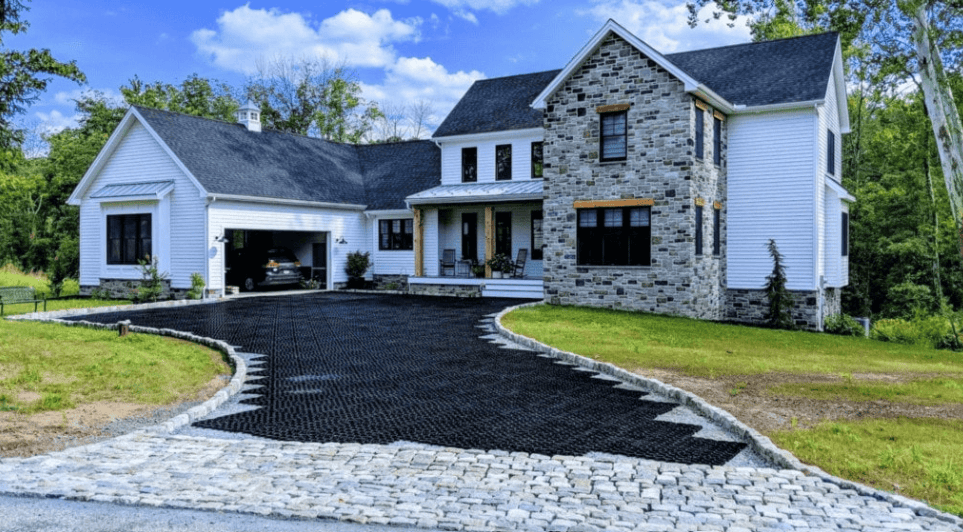
TRUEGRID® is an innovative alternative to traditional brick driveways. TRUEGRID® permeable pavers are a sustainable and eco-friendly solution for those seeking a durable and attractive driveway for their home or business. Made from 100% recycled plastic, TRUEGRID® pavers not only reduce plastic waste, they also allow rainwater to seep through in order to reduce surface runoff and promote groundwater recharge.
Pros of TRUEGRID® Permeable Pavers:
- Eco-Friendly: TRUEGRID’s commitment to sustainability makes it an eco-conscious choice. Its permeable design reduces stormwater runoff to help benefit the environment.
- Durability: TRUEGRID® pavers are highly durable and resistant to UV rays and stains, which makes them suitable for various climates.
- Low Maintenance: Unlike traditional brick driveways, TRUEGRID® requires minimal maintenance to save time and effort.
- Cost: TRUEGRID® permeable pavers are often times ⅓ to ½ the cost, per sq ft, vs brick pavers.
Cons of TRUEGRID® Permeable Pavers:
- Limited Design Options: With a wide variety of infill gravel choices, TRUEGRID® offers versatility, however, it may have somewhat limited design capabilities compared to traditional brick. The range of colors and patterns with brick may be more extensive to allow for intricate and custom designs.
- Grass Infill Limitations: When grass infill is used with TRUEGRID, traffic frequency is limited to about four or fewer passes per day to protect the grass blades from overuse.
Real-Life Examples:
EVENT CENTER PARKING, DAYTON, TX
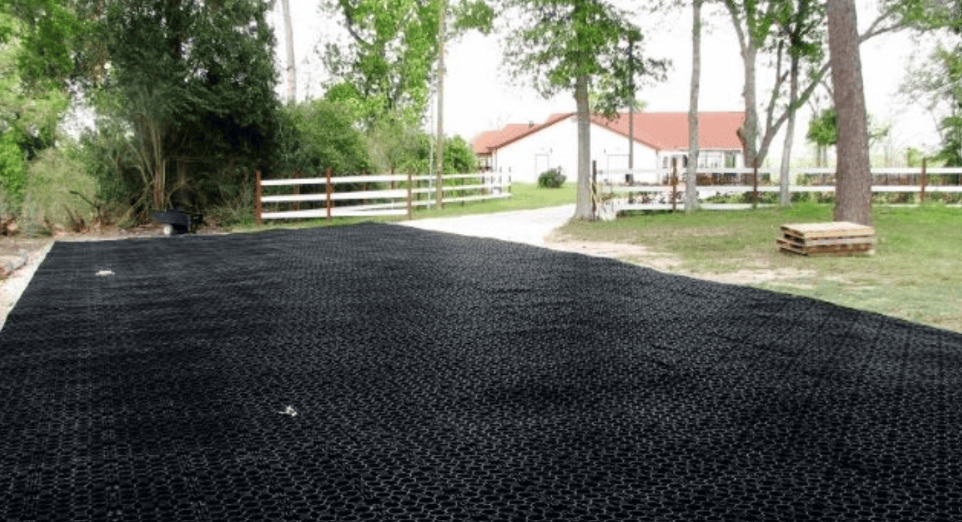
A compelling real-life example of TRUEGRID® in action is at the Event Center Parking, in Dayton, Texas.. The center required a permeable, durable, and aesthetically pleasing solution for their parking lot, and TRUEGRID® delivered, by transforming the space into a functional and eco-friendly parking facility that could withstand heavy vehicle traffic.
NEW BRAUNFELS STORAGE FACILITY, NEW BRAUNFELS, TX

The New Braunfels Storage Facility in Texas is another testament to the performance and sustainability of TRUEGRID®. The facility needed a sturdy and permeable surface for their RV and boat storage, and TRUEGRID® pavers were the perfect solution. The result is a high-performing, eco-friendly surface that effectively manages stormwater, reduces the heat island effect, and provides a robust surface for heavy vehicle storage.
Upgrade to TRUEGRID®: Discover the Eco-Friendly Alternative to Brick Driveways
Discover the future of sustainable driveways withTRUEGRID® permeable pavers. Experience the unmatched durability and eco-conscious design that our solutions offer.
Contact us today for more information!
Steep driveways can pose challenges, and this article presents various design ideas to successfully manage them. Discover minimalist styles, high-tech solutions, artistic flairs, and sustainable designs offered by TRUEGRID®. These options provide unique advantages and potential to increase your property value.
Navigating Steep Driveway Complexities: More Than Just Incline Issues
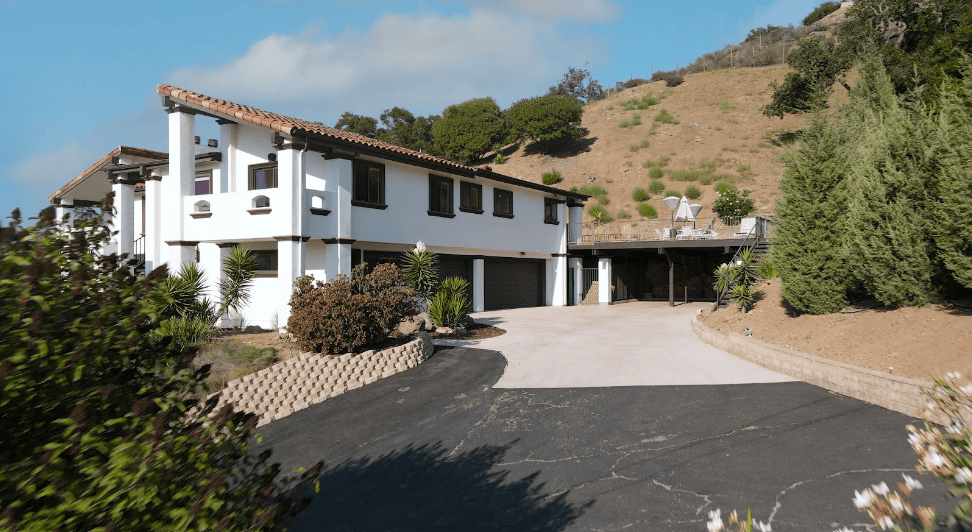
Steep driveways can present a unique set of difficulties for homeowners. Aside from the obvious challenge of navigating the incline, they often pose issues in terms of design and functionality. Harsh weather conditions can exacerbate these problems, and make the driveway slippery and potentially dangerous. Moreover, the steep gradient can cause water runoff that can lead to erosion or damage to nearby structures.
However, with the right design ideas for your steep driveway, these challenges can be turned into unique opportunities for enhancing the appearance and value of your home.
Common Difficulties with Steep Driveways
Steep driveways can be difficult, particularly in integrating them into the overall landscape design. A steep slope can often stand out as intrusive, especially in contrast to a predominantly flat property. It poses a significant design challenge that requires thoughtful planning to ensure that the driveway blends with its surroundings.
Material Selection
- The choice of materials is critical for durability, considering the wear and tear due to the incline.
- Aesthetics also play a vital role, so the materials should be visually appealing.
In terms of practicality, managing water runoff is a critical concern. Without proper drainage solutions, water can cascade down the driveway that can potentially lead to erosion or damage to the driveway surface.
Navigational Challenges
- The steep gradient can pose difficulties for vehicles, particularly in adverse weather conditions like rain or ice.
- Addressing safety concerns is essential in order to prevent accidents.
Despite these challenges, there are numerous innovative and creative ideas for steep driveways. These ideas not only address the functional and safety aspects, they can also turn steep driveways into architectural highlights that enhance the property’s overall appeal.
Innovative Design Ideas for a Steep Driveway
1. Minimalist Styles
Minimalist styles in steep driveway design focus on simplicity and functionality by embracing a minimalist approach, so that homeowners can transform a steep driveway into a sleek and modern feature of their property.
Advantages
Simplicity and Elegance
The minimalist style, with its clean lines and uncluttered appearance, adds a contemporary and sophisticated look to the property.
Low Maintenance
Minimalist designs typically require less upkeep due to their straightforward and uncomplicated nature, which makes them ideal for steep driveways where maintenance can be more challenging.
Increased Home Value
Curb Appeal
A minimalist driveway enhances the property’s curb appeal and makes it more attractive to potential buyers who appreciate modern aesthetics.
Functional Appeal
The functional simplicity of a minimalist driveway appeals to buyers looking for practicality and ease of use, particularly in challenging steep terrains. This functionality, combined with the aesthetic appeal, can significantly boost the home’s market value.
2. High-tech Applications
The incorporation of high-tech applications in steep driveway designs represents a forward-thinking approach to addressing the unique challenges of steep driveways. This concept involves utilizing advanced technologies to enhance functionality and safety by turning a steep driveway into a cutting-edge feature of the home.
Advantages
Enhanced Safety Features
Technologies like automatic de-icing systems or heated driveway surfaces prevent ice buildup, which makes the driveway safer to navigate in winter conditions.
Smart Drainage Solutions
Advanced drainage systems that can be controlled remotely or are equipped with sensors to ensure efficient water management can reduce erosion and surface damage risks.
Increased Home Value
Modern Appeal
Homes with high-tech driveways appeal to tech-savvy buyers and those who appreciate modern conveniences, which helps make the property stand out in the real estate market.
Long-Term Durability and Efficiency
The implementation of high-tech solutions in driveway design can lead to increased durability and lower maintenance costs. This efficiency and longevity are attractive features for potential buyers, and can potentially increase the home’s resale value.
3. Multi-material Surfaces
Incorporating multi-material surfaces in steep driveway designs is a versatile and dynamic approach. This design strategy involves using a combination of different materials, such as concrete, asphalt, gravel, and pavers, to create a driveway that is not only functional, but also visually appealing.
Advantages
Improved Traction and Durability
Different materials can provide better grip and durability in specific areas of the driveway to help address the challenges of steep slopes.
Aesthetic Diversity
The use of multiple materials allows for creative patterns and designs to enhance the driveway’s visual appeal and complement the home’s overall landscaping.
Increased Home Value
Unique Curb Appeal
A driveway with a blend of materials can make a property stand out by offering a unique aesthetic that can be a major selling point.
Customization and Quality Perception
Potential buyers often perceive customized features as a sign of quality. A well-designed multi-material driveway can be seen as a premium addition that can potentially increase the property’s market value.
4. Geometric Patterns
Geometric patterns in steep driveway designs bring an artistic and structured element to the property. This design concept involves creating visually striking patterns using shapes like squares, rectangles, and triangles, often through the use of different paving materials or color variations.
Advantages
Visual Interest and Appeal
Geometric patterns create a visually engaging and dynamic look that can turn the driveway into a focal point of the property’s exterior.
Enhanced Texture and Traction
The use of varied materials and patterns can also enhance the texture of the driveway surface to provide better traction on steep slopes.
Increased Home Value
Distinctive Curb Appeal
A driveway with unique geometric designs can significantly enhance the property’s curb appeal to make it stand out in a competitive real estate market.
Perception of Customization and Luxury
Geometric patterns often give a perception of high-end customization and luxury. This aesthetic distinction can appeal to potential buyers looking for unique properties, and potentially boost the home’s resale value.
5. Sustainable Methods
Sustainable methods in steep driveway design focus on environmentally-friendly and resource-efficient practices. This approach includes using recycled materials, permeable paving options, and integrating green landscaping elements to create a driveway that is both eco-conscious and aesthetically pleasing.
Advantages
Environmental Impact and Efficiency
Utilizing sustainable materials and methods reduces the environmental footprint and can improve the driveway’s water management by minimizing runoff and erosion.
Long-Term Cost Savings
Eco-friendly driveways often result in reduced long-term maintenance costs due to the durability and efficiency of the materials used.
Increased Home Value
Growing Market Demand
There is a growing trend and demand for sustainable homes. A driveway designed with eco-friendly practices can be a significant selling point for environmentally-conscious buyers.
Enhanced Property Value
Sustainable features are increasingly seen as premium additions to homes. Incorporating them into a driveway design can increase the overall value of the property, both in terms of market value and in its appeal to a broader range of potential buyers.
6. Artistic Flairs
Incorporating artistic flairs into steep driveway designs can transform a functional space into an expression of creativity and personal style. This approach can include the use of color, intricate patterns, artistic inlays, or even the integration of sculptures and landscape art along the driveway.
Advantages
Unique Personalization
Artistic elements in a driveway design add a unique touch that reflects the homeowner’s personal style and artistic taste to make the space more than just a functional area.
Visual Enhancement
Artistic enhancements can turn the driveway into a visually striking feature that adds to the aesthetic appeal of the entire property.
Increased Home Value
Distinctive Character
A driveway with artistic flairs adds a distinctive character to the home and makes it stand out in the housing market. This uniqueness can be particularly appealing to buyers looking for a property with a special touch.
Perceived Luxury and Exclusivity
Artistic additions often give a sense of luxury and exclusivity, which can be a major draw for potential buyers. This perception of exclusivity can significantly increase the perceived value of the home and potentially lead to a higher resale value.
7. Plant-life Accents
Incorporating plant-life accents in steep driveway designs adds a natural and refreshing element to the landscape. This concept involves integrating greenery, such as border gardens, shrubs, or even climbing plants along retaining walls, to create a driveway that is both functional and harmoniously connected with nature.
Advantages
Aesthetic and Environmental Benefits
The addition of plants enhances the visual appeal of the driveway and contributes to environmental health by supporting local flora and fauna.
Improved Curb Appeal
Greenery can soften the hard lines of a steep driveway to make the space more inviting and visually pleasing.
Increased Home Value
Enhanced Property Aesthetics
Homes with well-integrated landscaping, including the driveway area, are often more attractive to buyers because they offer a complete and cohesive aesthetic.
Perceived Value of Green Spaces
In the current housing market, there is a growing appreciation for green spaces. A driveway with plant-life accents can be seen as an extension of the home’s living space that can potentially increase its overall market value.
8. Water Features
Adding water features to steep driveway designs introduces an element of tranquility and aesthetic appeal. This could involve incorporating elements like small cascading waterfalls, fountains, or reflective pools along the sides, or at the base of the driveway, to blend functionality with a touch of nature.
Advantages
Visual and Auditory Appeal
Water features add a visually appealing and calming effect that can enhance the overall ambiance of the driveway area.
Natural Cooling Effect
The presence of water can create a microclimate that provides a cooling effect in the surrounding area, which can be especially pleasant in warmer climates.
Increased Home Value
Luxury and Uniqueness
Water features are often associated with luxury and they can make a property stand out by offering a unique selling point.
Attractiveness to Potential Buyers
The aesthetic and calming effect of water features can be a major draw for potential buyers that can potentially increase the home’s desirability as well as its market value.
Transforming Sloped Driveways with Innovative Paving Techniques
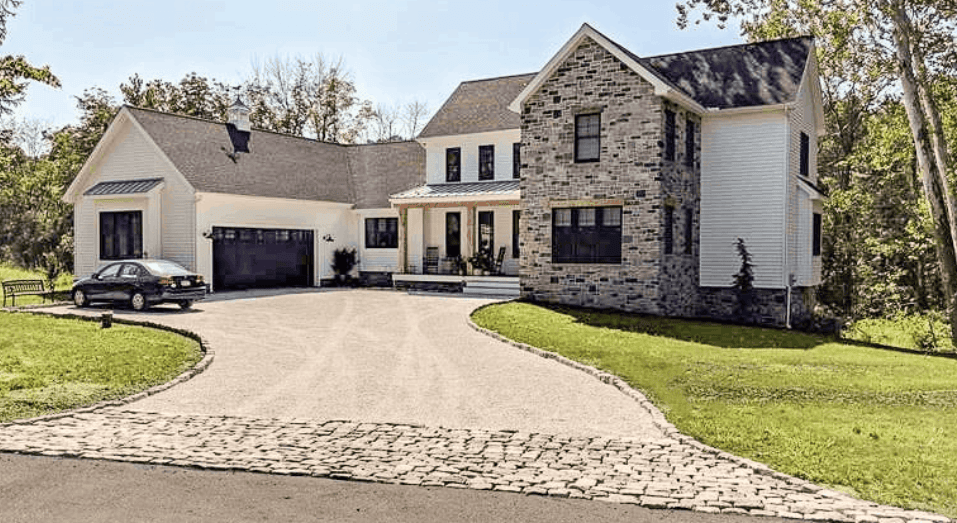
TRUEGRID®, founded in 2013, has emerged as a leader in eco-friendly paving solutions, by offering a sustainable alternative to traditional concrete and asphalt pavements. Their commitment to the environment is evident in their use of 100% post-consumer recycled materials collected in the USA for their products.
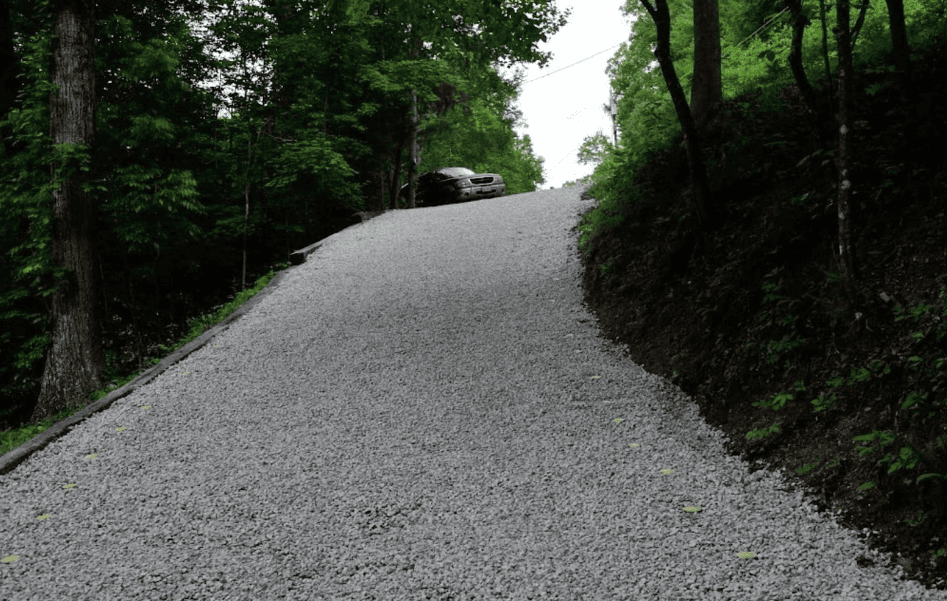
TRUEGRID® PRO PLUS®, is a product designed to be durable, flexible, and suitable for various applications, including residential, commercial, and industrial projects.
Eco-Friendly and Efficient
TRUEGRID® PRO PLUS® is eco-friendly and they address environmental challenges like stormwater runoff, soil erosion, and pollution. PRO PLUS® is more permeable, cost-effective, and requires minimal maintenance compared to traditional paving materials.
Diverse Applications
TRUEGRID® products are incredibly versatile. With a wide range of applications from driveways to parking lots and fire lanes, TRUEGRID® pavers ARE a sustainable solution for any paving need. They have been installed by notable companies like Google, AutoNation, Whole Foods Markets, and NASCAR, which demonstrates their adaptability and strength in diverse settings.
TRUEGRID’s innovation in permeable paving is a forward-thinking approach to driveway and pavement solutions that focuses on sustainability, durability, and eco-friendliness.
TRUEGRID®: Unveiling New Possibilities for Your Steep Driveway
Embrace the future of steep driveway design with TRUEGRID® innovative solutions. Discover how our eco-friendly, durable permeable pavers can transform your driveway for both aesthetic appeal and practical functionality.
Contact us today for more information!
The construction industry is changing towards greener practices for a sustainable future. Sustainable construction materials are key to reducing environmental impact and improving the durability of structures. These materials play a crucial role in revolutionizing the industry’s commitment to sustainability and building in harmony with nature.

The Building Industry Shift to Sustainable/Green Construction Materials
The building industry is increasingly embracing sustainable materials due to growing environmental awareness and the urgent need to address climate change.
The Importance of Sustainable Building Materials
What Makes a Building Material Sustainable?
A building material is considered sustainable if it meets certain environmental and social criteria. Key factors include:
- The material’s ability to reduce carbon footprint
- It must minimize energy consumption during production
- Comes from renewable or recycled sources
- Offers better energy efficiency to lower long-term operational costs
- Has a longer lifespan that reduces the need for frequent replacement, in order to limit waste
Regulatory pressures and evolving consumer preferences also drive this shift, as more people demand eco-friendly living spaces. Technological advancements have made sustainable materials more accessible and cost-effective to encourage their use in modern construction.
The Most Popular Sustainable Building Materials Used Today
1. Recycled Plastic and Polymeric Timbers
Recycled plastics are increasingly used in construction as an eco-friendly alternative to traditional materials.
Uses
Polymeric timbers, made from a blend of recycled and virgin plastics, are used in structures like fences and picnic tables. Recycled plastics are also spun into fibers for carpets and used in products like cable pipes and PVC windows.
Benefits
Recycled plastic materials offer significant environmental benefits such as reduced landfill waste and to curb deforestation. They also have superior durability and weather resistance that leads to longer life spans and reduced maintenance costs.
2. Reclaimed Wood
Reclaimed wood that has been sourced from retired barns, excavation sites, and shipping pallets is an environmentally responsible solution.
Uses
While it’s lighter and may need additional treatment against insects and degradation, its applications in cabinetry, flooring, and structural framing are notable for their sustainability.
Benefits
Reclaimed wood not only boosts the aesthetic appeal of a building, it also reduces the demand for fresh timber and contributes to forest conservation. It provides a distinct, rustic charm that makes each piece unique and rich with history.
3. Recycled Steel
Recycled steel is an eco-friendly material derived from scrap metal and end-of-life vehicles and appliances.
Uses
Its use in roofing, building facades, and structural support highlights its durability and eco-friendliness.
Benefits
This resource-efficient approach not only reduces the need for mining and processing virgin materials, it also significantly decreases the energy consumption and CO2 emissions associated with conventional steel production.
4. Plant-Based Polyurethane Rigid Foam
Made from natural materials like bamboo, hemp, and kelp, it offers excellent thermal insulation, resistance to mold and pests, and soundproofing qualities.
Uses
Originally innovated for surfboards, polyurethane rigid foam is now widely used for insulation in buildings.
Benefits
The plant-based polyurethane rigid foam is a sustainable option that reduces reliance on petroleum-based materials to minimize environmental harm.
5. Sheep’s Wool Insulation
Sheep’s wool insulation is a natural, renewable insulating material derived from the fleece of sheep, without causing harm to the animal.
Uses
It is an excellent heat insulator that is known for its superior moisture regulation and sound absorption properties. Sheep’s wool is an effective natural insulator that provides both energy efficiency and soundproofing.
Benefits
Sheep’s wool insulation offers numerous benefits such as minimal environmental impact due to its renewable source, significantly less energy for production compared to synthetic insulators, and excellent performance in both warm and cold climates. Its natural flame resistance and ability to regulate indoor humidity levels further make it a prime choice for sustainable construction.
6. Rammed Earth
Rammed earth is an ancient construction technique that has been experiencing a resurgence in the sustainable building field. It involves the compacting (or “ramming”) of damp earth mixture into an externally supported frame or mold in order to create solid walls of earth. Once the material is dried, the frame can be removed to reveal a strong, durable structure.
Uses
Rammed earth is used in walls, floors, and even in the construction of entire buildings. It is especially suitable for low-rise construction and can be left exposed or covered with plaster for aesthetic purposes.
Benefits
It is an environmentally-friendly construction method, as it primarily uses local soil to reduce the transportation and manufacturing impacts. Rammed earth provides excellent thermal mass, helps to moderate indoor temperatures, and reduces the need for artificial heating and cooling. This construction method is also highly durable and can last hundreds of years if properly maintained.
7. Mud Brick
Mud brick, also known as adobe, is a time-honored construction material made from earth and water, and often enhanced with organic materials like straw for added strength and durability.
Uses
Traditionally, mud bricks are used for constructing homes, particularly in developing countries. They are ideal for low-rise construction and can be left exposed or plastered for aesthetic purposes.
Benefits
The production of mud bricks is energy-efficient and produces minimal waste, which makes it a highly sustainable choice. Buildings made from mud brick have excellent thermal performance that keeps the interiors cool during the summer and warm during the winter. This natural temperature regulation reduces energy costs associated with heating and cooling systems. Mud bricks are also biodegradable and recyclable to further enhance their eco-credentials.
8. Hempcrete
Hempcrete is an innovative and sustainable material that is made from hemp fibers, lime, and water. It is lightweight, breathable, and provides excellent insulation, which makes it a popular choice in the green construction industry.
Uses
Hempcrete is mainly used as insulation in new build houses or for renovating old buildings. It is ideal for wall, floor, roof, and attic insulation.
Benefits
Hempcrete is carbon-negative, which means that it absorbs more CO2 during hemp plant growth than emitted during production. This unique characteristic makes it an excellent option for sustainable and eco-conscious projects. It is also strong, durable, and recyclable, to further enhance its sustainability credentials.
9. Pre-Fabricated Wood Products
Pre-fabricated wood products are made off-site in standardized sections and put together on-site. They are a sustainable and eco-friendly solution for construction.
Uses
These products, including trusses, frames, and even whole buildings, are used in various construction applications due to their flexibility, versatility, and quick assembly time.
Benefits
They provide several benefits such as reduced construction waste, minimized onsite labor, and shortened construction time.
10. Mass Timbers
Mass timber encompasses a range of framing styles that utilize solid wood panels for erecting walls, floors, and roofs. This approach offers not only structural integrity, it also showcases the aesthetic appeal and adaptability of wood as a construction material. It includes pioneering products such as glued laminated timber (glulam), cross-laminated timber (CLT), and laminated strand lumber.
Uses
Mass timber finds extensive use in a diverse range of applications, including multi-story buildings, bridges, and long-span structures. Its exceptional strength-to-weight ratio makes it highly suitable for large-scale constructions.
Benefits
Mass timber is considered highly sustainable as it is derived from a renewable resource. It serves as a carbon sink that effectively stores the CO2 absorbed by trees during their growth phase, so it helps contribute to the reduction of greenhouse gas emissions. Moreover, mass timber has exceptional thermal performance, fire resistance, and aesthetic appeal, which makes it a favored option for environmentally-friendly construction practices.
11. Salvage Materials
Salvage materials refer to used or recycled materials that can be repurposed for new construction projects. Frequently sourced from deconstructed or renovated structures, these materials encompass reclaimed wood, metal, bricks, glass, and other elements.
Uses
Salvage materials have diverse applications in construction, spanning from framing and flooring to roofing and interior design elements.
Benefits
Incorporating salvage materials in construction offers numerous advantages:
Reduces the reliance on new resources
Aids in diverting waste away from landfills
Materials are usually less expensive
12. American Bamboo
Guadua angustifolia, commonly known as American Bamboo, is a rapidly growing plant that is predominantly found in the Americas. It is increasingly being acknowledged as a sustainable construction material because of its exceptional properties and environmentally-conscious characteristics.
Uses
This versatile material is used in different areas like flooring, wall cladding, furniture, and even structural frames for buildings. Its strength and durability make it an excellent alternative to traditional hardwoods.
Benefits
American Bamboo is a highly-renewable resource that matures in just 3-5 years, much faster than hardwoods that take decades. Its rapid growth makes it an excellent carbon sink, and it absorbs substantial amounts of CO2 from the atmosphere. Bamboo is also impressively strong and durable, and it is comparable to steel in terms of tensile strength. Its lightweight nature contributes to cost-effective transportation to help reduce the carbon footprint in construction.
13. Mycelium
Mycelium, the vegetative part of a fungus, is composed of a network of delicate white filaments. This fascinating organic material is currently being studied for its immense potential to transform sustainable construction practices.
Uses
Mycelium is an exceptional material with the ability to produce building blocks. These blocks possess remarkable strength and lightness, while also serving as excellent insulators. Their practical applications span a wide range, such as wall insulation, acoustic dampening, and even structural components in the construction industry.
Benefits
Mycelium-based products are renowned for their organic composition, compostability, and utilization of waste materials, which makes them an exceptional zero-waste construction alternative. Not only do they exhibit fire resistance and excellent insulation properties, they also refrain from emitting harmful substances during production and disposal. These remarkable attributes establish mycelium products as a viable and sustainable option for traditional construction materials. The growth of mycelium aids in the absorption of CO2 which helps to make a significant contribution to carbon sequestration.
14. Cork Products
Cork is a renewable and sustainable material that is derived from the bark of the cork oak tree. Its unique properties like lightness, elasticity, impermeability, and thermal and acoustic insulation make it an interesting choice for sustainable construction.
Uses
Cork is often used in construction for insulation, flooring, wall coverings, and even as a structural material in some cases. Its lightweight, resilient, and natural insulation properties make it a versatile and effective construction material.
Benefits
Cork is a renewable resource that is harvested from the bark of cork trees without causing any harm to the tree. This sustainable harvesting method, coupled with cork’s biodegradability, makes it an environmentally-friendly construction choice.
Cork has natural thermal and acoustic insulation properties that can enhance the energy efficiency of buildings by reducing energy use and the associated carbon footprint.
15. TRUEGRID® Permeable Pavers: A Sustainable Solution
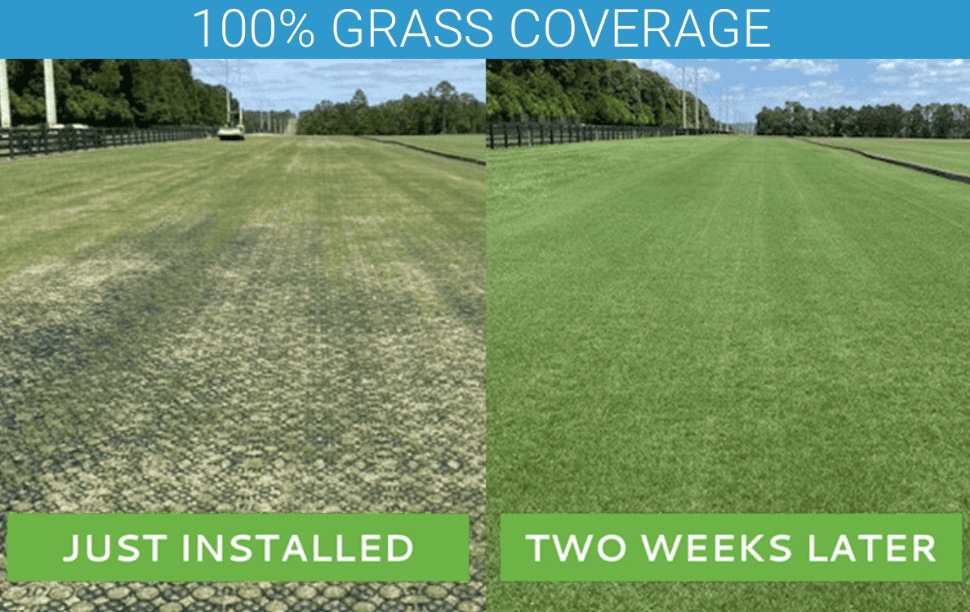
TRUEGRID®, a leading provider of eco-friendly construction solutions, offers products that embrace sustainability principles. Their pavers, which are crafted from 100% post-consumer recycled plastic, ARE a long-lasting, permeable, and environmentally-friendly option for a wide range of applications.
Uses
TRUEGRID® permeable pavers are highly versatile and can be used for various applications such as driveways, parking lots, trails, and high-traffic areas.
With a durable design, they can withstand heavy loads, which makes them suitable for both residential and commercial construction projects. Their exceptional water percolation capabilities make them an excellent solution for stormwater management and flood prevention.
Benefits
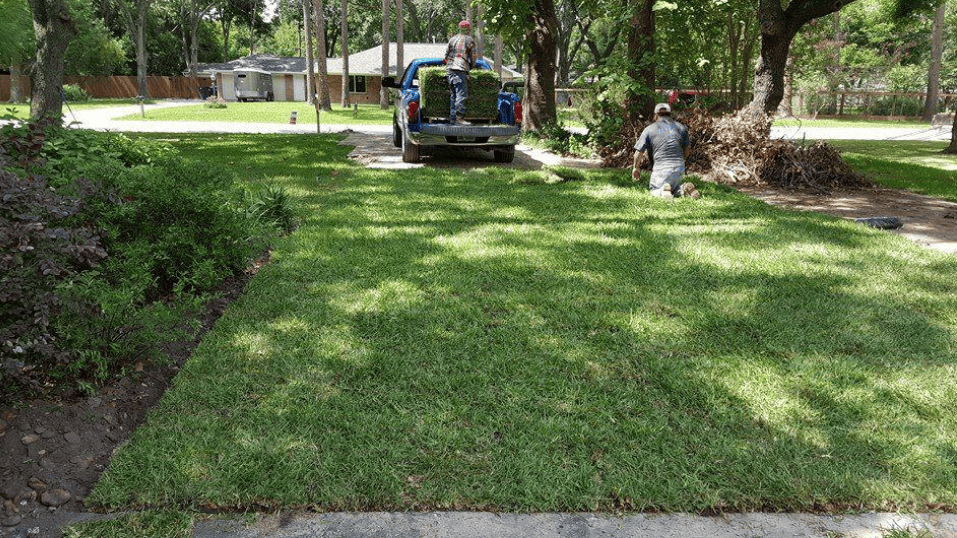
TRUEGRID® permeable pavers have several benefits. They are made entirely from 100% post-consumer recycled plastic to help reduce plastic waste. Their permeability also helps with water management and flood prevention, which makes them a sustainable and practical choice for construction projects.
Upgrade Your Construction Practices with TRUEGRID® Sustainable Solutions
Embrace the future of sustainable construction with TRUEGRID® permeable pavers. Opt for an environmentally friendly choice that not only meets your construction needs, but also contributes to a greener and healthier planet!
Contact us today for more information.
Overflow parking is a common problem faced by businesses, event venues, and public parks. When visitor numbers exceed expectations, parking areas quickly become overcrowded which can lead to vehicles being parked on grassy fields or any available space. This not only damages the environment, it can also cause various other issues. In this article, we will discuss the problems caused by overflow parking and introduce an innovative solution – TRUEGRID® Permeable Pavers.
Understanding the Need for Overflow Parking
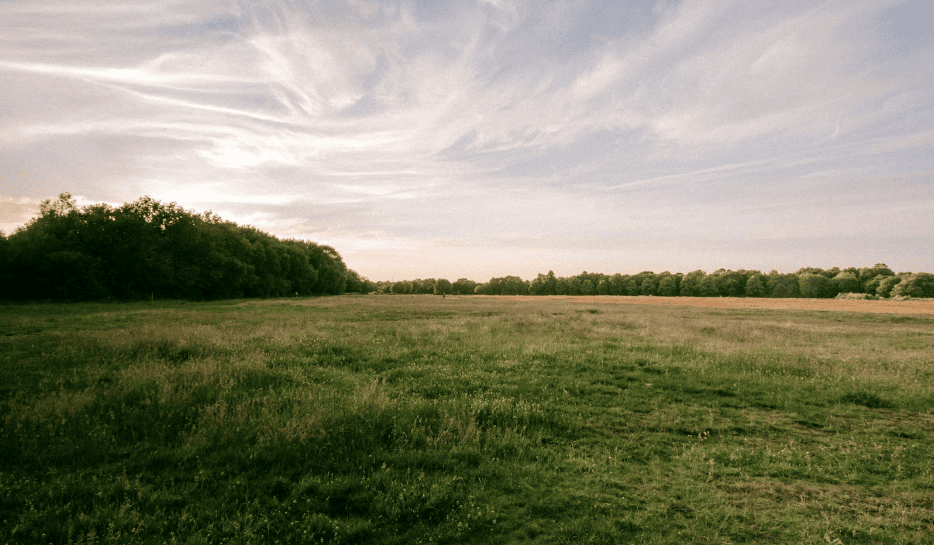
Overflow parking is essential for accommodating excess vehicles during peak times or special events. Traditional methods like asphalt or concrete lots can be costly and environmentally unfriendly. Permeable pavers are a cost-effective, durable, and eco-friendly alternative.
These innovative solutions mitigate soil compaction and promote better drainage to help ensure that grassy areas used for overflow parking maintain their health and appearance. This approach not only preserves the natural landscape, it also aligns with sustainable land management practices.
The Problems with Traditional Overflow Parking
Torn Grass Fields
Traditional overflow parking often leads to damaged and torn grass fields, especially in areas with frequent rain or heavy vehicle use. This not only diminishes the aesthetic appeal of the landscape, it can also lead to long-term soil degradation and increased maintenance costs.
Traffic-Related Issues
Overflow parking on inadequate surfaces can cause traffic congestion and disorganization. Without clear parking delineations, vehicles may end up blocking pathways which can cause safety hazards and inefficiencies in traffic flow.
Disappointed Visitors
Poorly managed overflow parking can lead to visitor dissatisfaction. Difficulty in finding suitable parking spaces, navigating through muddy or uneven surfaces, and long walks from the parking area to the event venue can negatively impact the visitor experience.
Uncomfortable Parking Situations
Overflow parking areas, especially those improvised on uneven terrain or grassy fields, can result in uncomfortable parking situations. Vehicles may be parked at odd angles, in tight spaces, or on unstable ground, which can lead to difficulties in parking and retrieving vehicles.
Environmental Impact
Traditional parking solutions often involve impermeable surfaces like asphalt or concrete, which contribute to increased runoff and reduced groundwater recharge. This can lead to environmental issues such as flooding, pollution of local waterways, and disruption of natural habitats.
Increased Maintenance Costs
Maintaining traditional overflow parking areas, especially those not designed for heavy or frequent use, can be costly. The need for regular repairs due to wear and tear, along with the potential for environmental damage remediation, adds to the long-term expenses.
Each of these issues underscores the importance of seeking more sustainable and efficient solutions for managing overflow parking needs.
Introducing Permeable Pavers
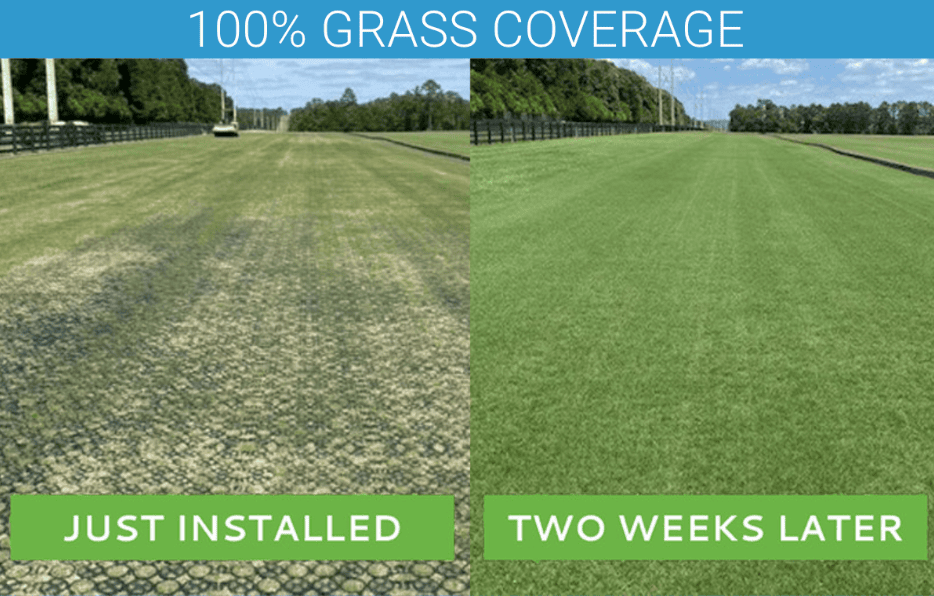
One viable solution to the issue of overflow parking is the use of permeable pavers, like those offered by TRUEGRID®. Their permeable pavers are an eco-friendly solution that blends functionality, durability, and aesthetics.
- Designed to let rainwater pass through and recharge groundwater in order to reduce the chances of flooding and erosion
- Created from 100%-recycled plastic to reduce waste
- Versatile design allows for quick installation and virtually no maintenance to save both time and money
- Robust construction ensures that they can withstand heavy vehicle traffic without degradation which makes them an ideal solution for overflow parking
With TRUEGRID® permeable pavers, you can manage parking overflow effectively while also preserving the natural landscape and reducing environmental impact.
Optimizing Overflow Parking with TRUEGRID®
TRUEGRID® products are versatile solutions for different types of overflow parking needs. They ensure a well-maintained appearance and functionality for various settings.
TRUEGRID® PRO LITE
TRUEGRID® PRO LITE is an innovative solution for light to moderate traffic overflow parking needs. Made from 100%-recycled high-density polyethylene, this product provides an eco-friendly, permeable, and long-lasting solution to prevent soil erosion and improve natural groundwater recharge. Its easy and quick snap feature enables cost-effective installation, which makes it suitable for commercial and residential use.
TRUEGRID® PRO PLUS®
TRUEGRID® PRO PLUS® is specifically designed for commercial, heavy-duty applications, including overflow parking for large events and high-traffic areas. Made from 100%-recycled high-density polyethylene, it provides sturdy support for heavy vehicles while also maintaining permeability for water runoff. Its robust design and efficient installation process make it an ideal solution for businesses seeking a sustainable, yet resilient, overflow parking solution.
TRUEGRID® ROOT®
TRUEGRID® ROOT® stands out as an affordable and effective option for grass protection. It preserves the natural look of your lawn and requires no permits for installation. This product is notable for its durability, with a lifespan of 60 years, and its environmental friendliness, since it is made from 100%-recycled plastic.
The Advantages of TRUEGRID® Pavers
TRUEGRID® permeable pavers provide a stabilized surface for gravel, grass, or dirt overflow parking:
- Simple to install and maintain
- Creates a professional appearance
- Provides built-in drainage
- Eliminates the need for additional costly drainage systems
Innovative Parking Solutions: Case Study Highlights
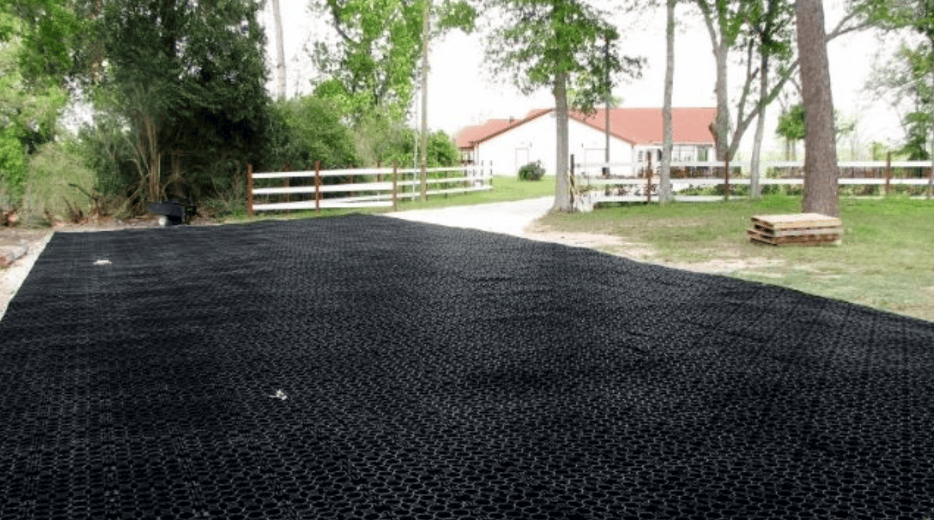
The Event Center Parking case study is an example of the transformative power of TRUEGRID® solutions. This large event venue, faced with the challenge of managing significant overflow parking, found an effective and sustainable solution in TRUEGRID® PRO PLUS®. The result is an efficient, cost-effective, and environmentally-friendly parking area that significantly enhances visitor experience and venue functionality.
Take the First Step Towards Sustainable Overflow Parking with TRUEGRID®
Let TRUEGRID® make a difference in your overflow parking solutions today. By utilizing our permeable pavers, you can ensure a dependable and lasting parking solution, while also making a significant contribution to a healthier and more sustainable environment.
Contact us today for more information!

